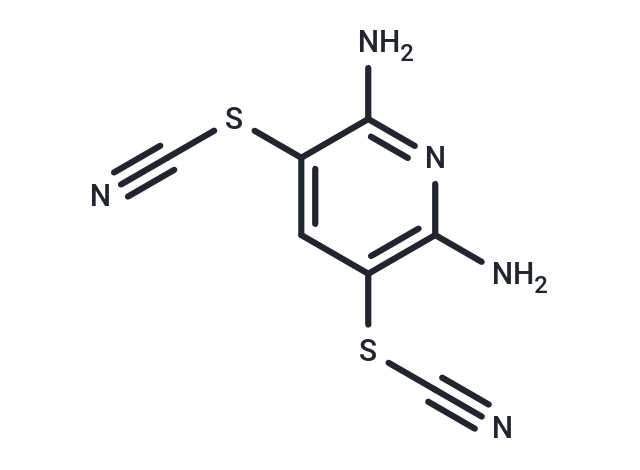Shopping Cart
Remove All Your shopping cart is currently empty
Your shopping cart is currently empty
PR-619 (2,6-Diamino-3,5-dithiocyanopyridine) is a DUB inhibitor that inhibits USP2/4/5/7/8 (EC50=7.2/3.93/8.61/6.86/4.9 μM). PR-619 induces endoplasmic reticulum stress and activates autophagy.

| Pack Size | Price | USA Warehouse | Global Warehouse | Quantity |
|---|---|---|---|---|
| 5 mg | $45 | In Stock | In Stock | |
| 10 mg | $55 | In Stock | In Stock | |
| 25 mg | $83 | In Stock | In Stock | |
| 50 mg | $113 | In Stock | In Stock | |
| 100 mg | $158 | In Stock | In Stock | |
| 200 mg | $238 | In Stock | In Stock | |
| 500 mg | $393 | - | In Stock |
| Description | PR-619 (2,6-Diamino-3,5-dithiocyanopyridine) is a DUB inhibitor that inhibits USP2/4/5/7/8 (EC50=7.2/3.93/8.61/6.86/4.9 μM). PR-619 induces endoplasmic reticulum stress and activates autophagy. |
| Targets&IC50 | USP8:4.90 μM(EC50), USP4:3.93 μM(EC50), UCHL3:2.95 μM(EC50), SENP6 core:2.37 μM(EC50), JOSD2:1.17 μM(EC50) |
| In vitro | METHODS: HEK293T cells were treated with PR-619 (5-50 µM) for 6 h. Target protein expression levels were measured by Western Blot. RESULTS: PR-619 interfered with probe labeling at concentrations of 5 µM and above. PR-619 inhibited probe labeling of USP7, but also targeted many other DUBs in the same concentration range, consistent with its broader inhibitory profile. [1] METHODS: The leukemia cell line K562 was treated with PR-619 (40 µM) for 2 h. Targeting was detected by Immunofluorescence. RESULTS: PR-619 induced a different distribution of TOP2A and TOP2B fluorescence signals, consisting of large signal foci. FK2 ubiquitin fluorescence signals partially overlapped with those of TOP2A and TOP2B, as well as SUMO2/3. [2] |
| In vivo | METHODS: To detect anti-tumor activity in vivo, PR-619 (10 mg/kg once daily) and cisplatin (10 mg/kg three times weekly) were intraperitoneally injected into Nude mice bearing T24 or BFTC-905 xenografts for three weeks. RESULTS: The combination of cisplatin and PR-619 showed the most significant antitumor effects on T24 and BFTC-905 xenograft tumors compared to monotherapy. [3] |
| Kinase Assay | Ub-PLA2 assay: Recombinant enzymes in 20 mM Tris-HCl, pH 8.0, 2 mM CaCl2 and 2 mM β-mercaptoethanol (DUB assay buffer) are preincubated with single doses or dose ranges of PR-619 or P22077 for 30 minutes in a 96 well plate before the addition of Ub-PLA2 and NBD C6-HPC. The liberation of a fluorescent product within the linear range of the assay is monitored at room temperature using a fluorescence plate reader. Vehicle (2%(v/v) DMSO) and 10 mM N-ethylmaleimide are included as controls. Where ≥60% inhibition is observed, EC50 values are determined using a sigmoidal dose response equation. |
| Cell Research | 72 h hours later, 0.2 mg/mL resazurin prepared in phosphate-buffered saline is added to each well and the cells are incubated for an additional 3-6 h. The fluorescence of the resazurin reduction product is measured using Ex=535 nm and Em=590 nm filters on a fluorimeter. The EC50 values are calculated in Prism.(Only for Reference) |
| Synonyms | PR 619, 2,6-Diamino-3,5-dithiocyanopyridine |
| Molecular Weight | 223.28 |
| Formula | C7H5N5S2 |
| Cas No. | 2645-32-1 |
| Smiles | Nc1nc(N)c(SC#N)cc1SC#N |
| Relative Density. | 1.61 g/cm3 (Predicted) |
| Color | White |
| Appearance | Solid |
| Storage | store at low temperature | Powder: -20°C for 3 years | In solvent: -80°C for 1 year | Shipping with blue ice/Shipping at ambient temperature. | |||||||||||||||||||||||||||||||||||
| Solubility Information | DMSO: 55 mg/mL (246.33 mM), Sonication is recommended. | |||||||||||||||||||||||||||||||||||
Solution Preparation Table | ||||||||||||||||||||||||||||||||||||
DMSO
| ||||||||||||||||||||||||||||||||||||
| Size | Quantity | Unit Price | Amount | Operation |
|---|

Copyright © 2015-2026 TargetMol Chemicals Inc. All Rights Reserved.